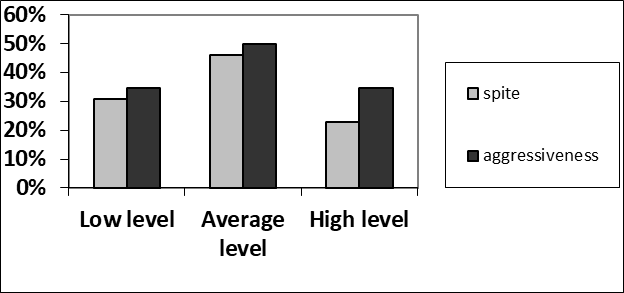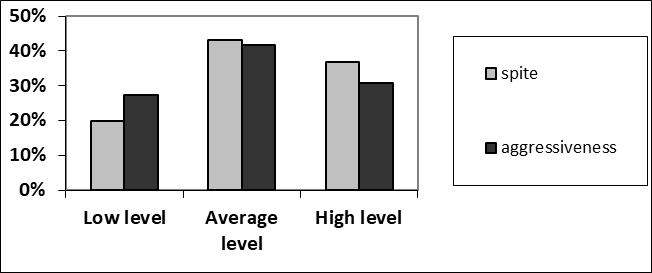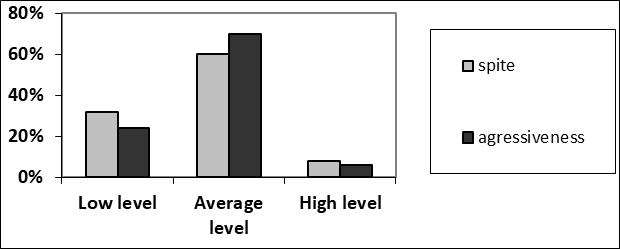Abstract
The article describes the results of the research on the basis of the North Caucasus Center for Inclusive Education of the Dagestan State Pedagogical University. The study involved schoolchildren with normotypic development and with disabilities of three age groups - primary school age, secondary school age and senior school age. In the course of the experiment, aimed at diagnosing the prerequisites for the formation of violent behavior among schoolchildren, we used: the Buss-Durkee questionnaire, the Leongard-Shmishek questionnaire, the method "Diagnosis of Conflict Level in a Class Collective" the level diagnostic technique self-assessment Dembo-Rubinstein. The pedagogical conditions for the prevention of school violence in inclusive education are: formation of the legal culture of schoolchildren; timely diagnosis of the social situation of education in conditions of inclusion; the formation in the school of a favorable social and pedagogical environment; the consideration of age specificity in the process of education of legal culture in schoolchildren: in primary school age, middle and senior school age; use of technology of pedagogical prevention of school violence.
Keywords: School violenceantisocial behaviourdeviant behaviourschoolchildrenviolence prevention
Introduction
In recent years, throughout the world, there has been an increase in violence and cruelty in society in general and in relation to children in particular (Mallaev & Omarova, 2008; Mallaev, Omarova, & Valiyeva, 2010). A high level of aggression and cruelty filled modern schools: students use cold and firearms, high-tech devices to demonstrate brutal behavior towards peers and educators on the Internet, harassment with the use of social networks, and more. In the 21st century, school violence acquired new social content. If earlier in the school environment violence in the form of teenage fights was a reaction to a threat, an attempt on freedom to restore one's rights and place in the social hierarchy, today the reason is the absence of a common identity, the difference between the aggressor and the victim (Omarova & Shakhova, 2013).
School violence is noted in all countries of the world, on all continents, and on January 27 it is declared the International day of struggle against bullying (school violence). The most vulnerable victims of violence in school are often children with disabilities.
Dagestan State Pedagogical University plays a special role in the development of inclusive education in the North Caucasus. Since 1989, the Department of Correctional Pedagogics and Special Psychology, the oldest in the North Caucasus, has been working at the State Pedagogical University. In 2014, the Faculty of Special Education was established in the South of Russia, and since 2015 - the Research Institute of Special Education, Clinical Psychology and Inclusive Education, on the basis of which research and educational activities are conducted aimed at providing conditions for the vocational education of individuals with disabilities (Mallaev & Omarova, 2018).
On the basis of the university, the North Caucasus Resource Center for Inclusive Education "Sozvezdie" (under the grant of the President of the Russian Federation, supported by the Foundation of Presidential Grants) was opened. The tasks of the center include:
the development of a methodological basis for a regional model for the inclusion of persons with disabilities in the field of general and vocational education;
the professional development of education and social protection personnel of the North Caucasus Federal District and the preparation of tutors for inclusive education;
creation of an advisory service for teachers, children with disabilities, parents and their individual psychological counseling;
the development of software and other information products on the organization of psychological and pedagogical support for persons with disabilities.
This allows for extensive research in the field of inclusive education. Within the framework of this article, a study will be made of the possibilities of preventing school violence in inclusive education.
Problem Statement
The research problem is a contradiction between the need of society and the state to protect children with disabilities from ill-treatment and the lack of scientific substantiation of pedagogical work on the prevention of school violence.
Research Questions
During the research we set ourselves the following questions:
What are the prerequisites for violent behavior at a younger school age?
What are the prerequisites for violent behavior in secondary school age?
What are the prerequisites for violent behavior in senior school age?
How does this affect children with disabilities in a context of inclusive education?
Purpose of the Study
The purpose of the study is to identify the prerequisites for violent behavior of schoolchildren in inclusive education.
Objectives of the study:
To study the socio-psychological prerequisites of school violence in inclusive education in junior school age.
To study the socio-psychological prerequisites of school violence in inclusive education at secondary school age.
To study the socio-psychological preconditions of school violence in inclusive education in the senior school age.
Research Methods
The study involved 300 schoolchildren with normotypic development and with disabilities. The study involved schoolchildren from Makhachkala and Sergokalinsky district of the Republic of Dagestan (130 pupils were students of the third classes, 120 pupils were students of the sixth grades, 50 pupils were students of the tenth classes).The following research methods were used:
the Buss-Durkee questionnaire (Buss & Durkee, 1957),
the questionnaire of Leongard-Shmishek (2014),
the method "Diagnosis of Conflict Level in a Class Collective" (Omarova, 2010, 2015; Omarova & Tselovalnik, 2017),
the level diagnostic technique self-assessment Dembo-Rubinstein (Rubinstein, 2004)
Findings
Among third grade students are more common children with an average level of hostility (46.2% - 60 children) and aggressiveness (50% - 65 children). A low level of hostility was demonstrated by 40 children (30.8%), aggressiveness - 45 children (34.6%). However, a certain number of schoolchildren with a high level of hostility (23% - 30 children) and aggressiveness (15.4% - 20 children) were noted. The results of the study in the third classes are shown in Figure

Sixth-grade pupils are also more likely to have children with an average level of hostility (43.3% - 52 people) and aggressiveness (41.7% - 50 children). A low level of hostility was demonstrated by 24 students (20%), aggressiveness - 33 children (27.5%). At the same time among the sixth graders the number of children with a high level of hostility (36.7% - 44 students) and aggressiveness (30.8% - 37 children) increased. The results of the study in the sixth grade are shown in Figure

A sharp increase in the high rates of hostility and aggressiveness we associate with the peculiarities of the puberty period, the psychoemotional changes in adolescence, the change in the leading activity.
A similar study in the upper grades of the school shows a tendency towards a gradual reduction of these indicators and an equalization of the emotional profile of schoolchildren.
Most students of senior school age demonstrated low and medium levels of hostility and aggressiveness. Among the students of tenth grades:
Low level of hostility (32% - 16 schoolchildren) and aggressiveness (24% - 12 schoolchildren).
The average level of hostility (60% - 30 students) and aggressiveness (70% - 35 students).
High level of hostility (8% - 4 students) and aggressiveness (6% - 3 schoolchildren).
The results of the research at the senior level of the school are shown in Figure

Diagnosis of the level of conflict was carried out at the primary, secondary and senior levels of the school. In primary school classes, the average level of conflict is 12.8%. At the same time, eight schoolchildren are distinguished by a high personal level of conflict. Comparison of the obtained data with the results of the Buss-Durkee questionnaire (Buss & Durkee, 1957) indicates that these students have a high level of aggression and hostility. Gender analysis of the obtained data shows that the majority of children with a high level of personal conflict are boys (in a sample of third-graders of such 7 people versus 1 girl).
Diagnosis of the level of conflict in the classroom in the middle school age allowed to get results that clearly demonstrate the growth of the number of conflict situations. The average level of conflict in the sixth grade was approximately 19.9%.
At the same time, the number of schoolchildren with a high level of personal conflict has increased. Of the one hundred and twenty schoolchildren in the sample of adolescent children, there were 23 such people. Conversations with the pedagogical collective showed that 11 of these twenty-three people (especially boys) are particularly harsh in conflict situations, preferring destructive (violent) methods of conflict resolution in interaction with peers. In relationships with adults, they prefer verbal aggression.
At the same time, school teachers note that in 9 schoolchildren, these manifestations became noticeable during adolescence, therefore teachers associate changes in behavior with pubertal changes and prefer sparing measures of influence, do not want to put them on record in the commission on affairs of minors.
Perhaps the hidden reason for this behavior of teachers can also be the desire to "not spoil the school indicators." As for the other twelve schoolchildren, the teachers note the variability of their behavior, dependence on the opinions of others, some signs of infantility in behavior and inability to cope with anger in difficult situations.
Teachers believe that in most cases the choice of these destructive forms of behavior by these students is situational and is not related to the characterological characteristics of the individual. With the appropriate psychological and pedagogical correctional effect, the forecast in terms of changing their behavior for the better is, in the opinion of class teachers and subject teachers, very favorable.
Gender analysis shows that the number of girls inclined to conflict behavior increases in adolescence, although boys are still leading in this indicator, accounting for more than two thirds of the number of children with conflict behavior.
The diagnosis of conflict among senior school age students is complicated by the fact that older students are aware of the presence of an experimenter in the classroom and tend to demonstrate normative behavior in their presence. Successfully overcoming the problems of the puberty period, senior school age students acquire more constructive communication and behavior skills. In addition, those students who had problems in adolescent behavior prefer to leave school after the ninth grade, which leads to the fact that in high school there are those who prefer to continue their studies and then enter higher education.
Due to the lack of recorded cases of high personal conflict level among high school students, gender analysis is not possible. Thus, in the tenth grade, the average level of conflict was 7.3%. At the same time, it should be noted that conversations with teachers open a slightly different picture. It was in the 10th grade of one of the schools in Makhachkala that a case of knife wounding a peer in the abdomen was registered (fortunately, the wound was not fatal). Therefore, we believe that the results of diagnostics in the senior classes need to be verified with other data.
Diagnosis of the peculiarities of self-assessment of schoolchildren using the "Dembo-Rubinstein" methodology (Rubinstein, 2004) was carried out similarly in the primary, middle and senior stages of the school.
In primary school classes, low self-esteem was found in 18% of children, adequate self-esteem - in 48% of children and overestimated self-esteem - in 34% of students who took part in the study.
At the same time, comparing these data with the results of the methodology for diagnosing the level of conflict, it should be noted that in children with a high level of conflict (in almost all 8 schoolchildren) and in 30 children with an average level of conflict (but approaching the upper threshold limits), the overestimated level of claims (self-assessment).
According to the results of the self-assessment study, the following data were obtained at the secondary level of the school: a low self-esteem is noted in 29.4% of schoolchildren, an adequate self-esteem in 48% of subjects and an overestimated self-esteem in 22.6% of children. Comparing the data of the study of self-esteem of junior schoolchildren with the data of adolescents, it should be noted the increase in the number of children with low self-esteem. This is probably the result of a lack of school success, which at the middle level of the school is becoming increasingly obvious.
It should be noted that out of 23 schoolchildren with a high level of conflict, an overestimated self-esteem was noted in 18 people, which allows us to conclude that an overestimated self-esteem is often an internal prerequisite for adolescent conflict behavior, since without recognition, such students seek to impose their a high level of claims through destructive forms of behavior. At the same time, the remaining 5 schoolchildren were diagnosed with a low level of self-esteem. Thus, in most cases, the increase in conflict is the result of inadequate self-esteem of the student (and, more often - overestimated self-esteem).
In the senior grades, a low level of self-esteem was noted in 12.3% of schoolchildren, 65.3% of high school students adequately assess their abilities, and 19.4% of students have an overestimated level of claims. Self-esteem becomes more and more adequate, children better assess their capabilities, are able to analyze their claims and match their capabilities. Probably, this is one of the reasons for the decline in conflict in the senior level of the school compared with the adolescent period.
The next stage was the study of the peculiarities of character accentuation in children who demonstrated high rates of conflict, hostility and aggressiveness against the background of inadequate self-esteem with the help of the questionnaire of Leongard-Shmishek (2014). In connection with the age specific application of the methodology, we confined ourselves to the middle level of the school.
According to the results of the study of 23 sixth-graders with a high level of conflict, we came to the conclusion that most of them are overlapping several accents. The most common combination is demonstrativeness + excitability + epileptoidity.
In the triad of accentuations "demonstrativeness + excitability + epileptoidy" the most significant indicator is epileptoidy, which carries characterological signs (malice, cruelty, propensity to violence), rather than signs of accentuation of demonstrativeness and excitability that have a psychophysiological link to the pubertal period.
Conclusion
The results of the experiment show that schoolchildren with such personality traits and social problems tend to have violent behavior as a high level of conflict in communicating with people of the nearest social environment, including peers, the presence of an epileptoid character accentuation, an inadequate level of self-esteem.
We noted that most often their victims are children with mental disabilities. Children with sensory deprivation (impaired vision or hearing) are less likely to be victims.
In subsequent articles, it is planned to outline the corrective work method for the prevention of school violence and pedagogical activity with victims of school violence.
Acknowledgments
My special thanks to the head of the Department of Correctional Pedagogics and Special Psychology of the Dagestan State Pedagogical University Jafar Mallaev for assistance in the research.
References
- Buss, A. H., & Durkee, A. (1957). An inventory for assessing different kinds of hostility. Journal of Consulting Psychology, 21(4), 343-349. https://doi.org/10.1037/h0046900
- Mallaev, D. M., & Omarova, P. O. (2008). Methods of teaching the rights of the child. Textbook for higher educational institutions. Makhachkala: Aleph.
- Mallaev, D. M., & Omarova, P. O. (2018). History of the establishment and development of special and inclusive education in Dagestan. News of DSPU, 3(12), 9-16.
- Mallaev, D. M., Omarova, P. O., & Valiyeva, P. V. (2010). Socialization of children with persistent school disadaptation of primary school age. St. Petersburg: Speech.
- Omarova, P. O. (2010). Characteristics of the social development of children with mental retardation. News of the Russian State Pedagogical University, 125, 69-77.
- Omarova, P. O., & Shakhova, R. M. (2013). Modern psychological and pedagogical studies of the problem of school violence. Modern problems of science and education, 2013.
- Omarova, P. O. (2015). Prospects for the development of general and professional education for persons with disabilities. Makhachkala: Dagestan State Pedagogical University.
- Omarova, P. O., & Tselovalnik, M. V. (2017). Social and psychological features of the persons with a combined sensory impairments. Dagestan State Pedagogical University Journal of Psychological and Pedagogical Sciences, 11(4), 12-22.
- Rubinstein, S. Ya. (2004). Experimental methods of pathopsychology and the experience their application. Moscow: April-press.
- The questionnaire of Leongard-Shmishek. (2014). Retrieved April 21, 2019 from https://psychojournal.ru/tests_online/119-oprosnik-shmisheka-akcentuacii-haraktera.html
Copyright information

This work is licensed under a Creative Commons Attribution-NonCommercial-NoDerivatives 4.0 International License.
About this article
Publication Date
23 January 2020
Article Doi
eBook ISBN
978-1-80296-077-8
Publisher
European Publisher
Volume
78
Print ISBN (optional)
-
Edition Number
1st Edition
Pages
1-838
Subjects
Teacher, teacher training, teaching skills, teaching techniques
Cite this article as:
Gasanova, Z. Z., & Omarova*, P. O. (2020). Diagnosis Of The Preconditions For School Violence In Inclusive Education. In R. Valeeva (Ed.), Teacher Education- IFTE 2019, vol 78. European Proceedings of Social and Behavioural Sciences (pp. 506-513). European Publisher. https://doi.org/10.15405/epsbs.2020.01.56
